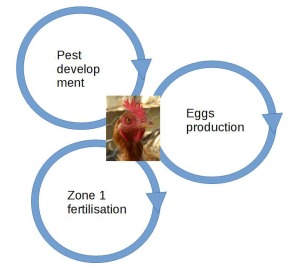Definition of Stacking Functions: Stacking Functions is done by an element which operates more than one function, in real-time or over time. The most used examples in Permaculture are chicken and trees. (see below examples of functions fulfilled by these 2 elements of an ecosystem).
It is rare that one element would produce only one function. Till now I could not find one example. The multi-functionality is a link between different biological cycles as shown in the picture;

The chicken fulfill among other functions; pest control for example eating the infested fruits fallen on the ground, affecting the propagation cycle of pest, It gives eggs in the process of food and more specifically animal protein production, it produces very rich manure for Zone 1 fertilization where there is the greatest density of food production. We may complete this vision by saying that every element in nature participate to 1 or more biological cycles.
We may go further and if assuming an equivalence between the resilience of a system and the number of biological cycles we may say that more multi-functional elements are added in the system more the ratio between cycles and elements increase and more adaptive and resistant to external impact is the system for the same given number of elements. Although this rule is correct only if we assume that we have enough elements to fulfill identical function.
A function is equivalent to an interaction in a process or biological cycle, it produces a resource or an action/event which relates to other elements of the ecosystem.
When designing an ecosystem, instead of overloading it with different elements it may be more constructive to reduce the number of elements and increase the number of positive interactions / functions. This can be done in two ways;
- integrating the most adapted elements, the one which fit the best by generating the most beneficial outcome
- optimizing this integration by locating elements so that interactions will express on the fullest and in the most energy efficient way
Chicken fulfill at least following functions
– Egg production
– Manure production
– Insect control
– Weed control
– Soil ventilation
– Meat production
– Soil preparation before planting
– Green house warming
– Produce feathers for compost or insulation
– etc.
Trees fulfill at least following functions (tree has breaking records in multifunctions)
– Light Harvesting
– Understory protection
– Humidity capture
– Life shelter (habitat)
– Compacted soil breaking
– Mulch production and fertilization of the dripping zone of the soil
– When a leguminous; symbioses with nitrogen fixing bacteria
– Building materials production
– Energy production (fire wood)
– Wind break
– Erosion prevention
– Water table rise (making water available for plants having shorter roots)
– Reduction of diurnal and nocturnal temperature variations
– Reduce risks of frost in early springs (key element in crop farming, e.g. Alley cropping)
– Orchestration of soil ecosystem evolution through sugar release, resulting in soil fertility
– Forests reduce the ocean turbidity on the coasts (by filtering human waste), main cause of coral death
– Produce oxygen
– Sequestrate carbon helped in a huge extend by their symbiosis with fungi
– Produce fruits and nuts when fruit and nuts trees. In the middle age chestnut was the main substitute to wheat flour
– Produce edible leaves in many cases (e.g. Pigeon Pea, Moringa, hibiscus, …)
– Produce rubber, the most high quality existing rubber when making tires (Hevea brasiliensis)
– Produce incense (Amesca, used by Amerindians)
– Produce condiments (cinnamon, …)
– Control salts excess in case of agriculture irrigation overuse
– etc.

One thought on “Stacking Functions in Permaculture”